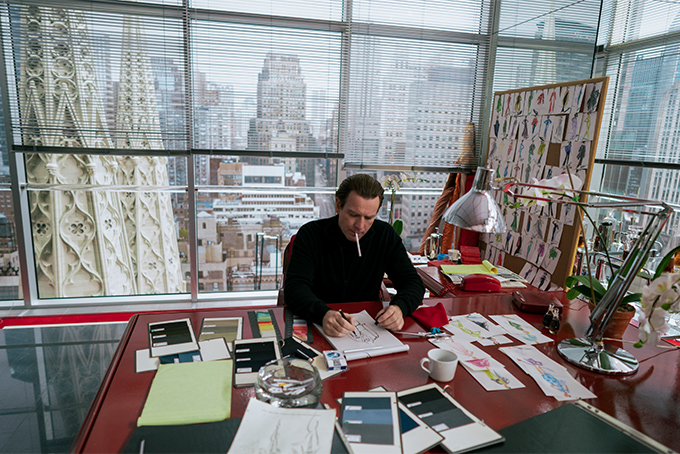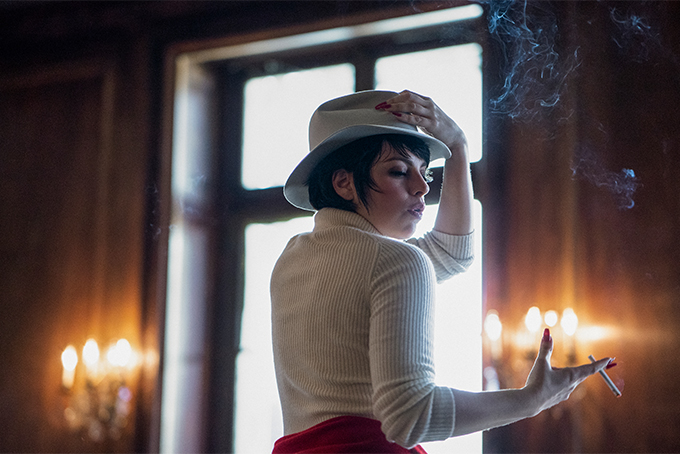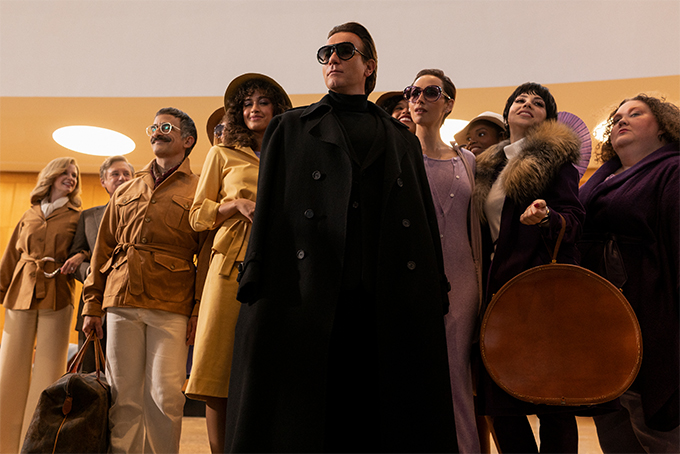“Elegance and ease, a sense of owning power without being masculine, and honouring the body that you have.”
“You were free inside your clothes.”
“He took away the cage.”
So Halston is described by his collaborators and admirers in a 2019 documentary chronicling his life from Iowa to Studio 54, where he reached the pinnacle of celebrity and redefined what it meant to be a fashion designer, before falling from grace in a torrid whirlwind of drugs, toxic relationships, and bad business decisions.

Before the fall of his empire, though, he made the name ‘Halston’ synonymous with ’70s glamour. Halston’s legacy is ultrasuede, wrap dresses, caftans, the bias cut, and the hotpants craze. Known for minimalism, ziplessness, and a sleek, flowing silhouette, his clothes were radical yet accessible to the everyday woman. The boy from Des Moines, Roy Halston Frowick, had a vision for all of his creations, the most important of which was himself. He self-mythologised endlessly, changing his accent and affect once he landed in New York, enveloping himself in an aura to become just Halston.
That makes the new Ryan Murphy-produced Netflix series about the designer’s life something of a twice-told tale. That doesn’t automatically render it an hackneyed or tired take on a legend, however; the designer’s profile declined greatly after he sold his name and company to JCPenney in 1983, seven years before his death from AIDS, and he is often forgotten when the luminaries of the era are tallied up today.

Indeed, the series’ star, Ewan McGregor, had never heard of Halston before being approached by series creators Dan Minahan and Christine Vachon. He fell in love with the photographs of the designer and his inner circle, telling The Hollywood Reporter, “I knew instantly… I wanted to play him. Just something about the way he holds himself, something in his eyes.” Signing McGregor to the project was a boon for Minahan and Vachon, who had been trying to get a film about Halston’s life made for nearly 20 years. Basing their pitch on the 1991 book Simply Halston by Steven Gaines, in 2019 they reimagined it as a limited series—which was finally greenlit by Netflix when powerhouse writer-producer Ryan Murphy came onboard.
The result is a five-part biopic of Halston’s life—easily consumable, comfortingly familiar, and distinctly unchallenging in the way that many of Murphy’s Netflix projects (among them The Boys in the Band, Ratched, The Politician, and Hollywood) tend to be. It skims over much of Halston’s early life, including his childhood and nascent career beginnings as a Bergdorf Goodman hatmaker in New York City, and by the end of the first episode lands squarely at the dawn of his glory years, with the launch of his first ready-to-wear collection in 1969.

Much of the rest of the series luxuriates in the following decade, jumping from his mirror-and-glass studio in Olympic Tower on Fifth Avenue to his swanky East Manhattan apartment to the newly-opened Studio 54, where Bianca Jagger rides in on that white horse and people abscond from the dancefloor to have sex on the balcony.
As the series goes on, though, there’s a distinct impression that Halston is losing control. Faithfully-recreated advertisements for mass market products like luggage and rugs—in one of the series’ only stylistic flourishes, the sequence climaxes with a dozen Halstons, each wearing an identical plastered-on smile, robotically intoning the same endorsement line—imply a bit too sharply that he’s diluting the power of his brand. He’s blowing through mountains of cocaine, struggling to keep the lights on, and pushing away his closest friends. Then he receives his diagnosis.
As celebrity stylist Joe Zee put it, “He was a victim of being first.” With no one doing what he was doing, staging fashion shows on Fifth Avenue with entire front rows made up of celebrities, there was no one whose successes he could emulate, or whose mistakes he could learn from. The disastrous billion-dollar, multiyear licensing deal with JCPenney haunted him until the end; but, Netflix’s Halston concludes, the undeniable impact he made on the industry ultimately overshadows that.

If Halston’s Halston comes across both as bombastic and petulant, that’s thanks in large part to McGregor’s performance. (That he’s also thinly-sketched is probably thanks to Murphy.) McGregor doesn’t much physically resemble the designer, lacking both Halston’s statuesque height and long, elegant fingers, and casting was initially met with noises of confusion by those who knew and loved the original man. But those in doubt have since voiced their support; as André Leon Talley, who coined the Halston-entourage name “Halstonettes,” told The New York Times, he saw flashes of his friend in the way McGregor pivoted, drawled, and held his cigarettes: “That Scottish man pulled it off.”
Though McGregor was smoking fake cigarettes (green-tea) and snorting fake cocaine (Inositol), much of the rest of his process was genuine. He met Halston confidant Liza Minelli for tea and a heart-to-heart, and spent months learning from the series’ true star, costume designer Jeriana San Juan, how to sew, cut, and pin. (San Juan consulted with the real Halston’s personal tailor, and managed to source a few vintage pieces from the designer’s archive to dress the actors and decorate the set.)
As a result, when we see McGregor conjure ‘Halston’ at the end of the first episode—pulling on a black turtleneck, slicking back his hair, and slathering on Guerlain bronzer—we’re really seeing Halston do ‘Halston.’

Another standout in the series is the ineffable Krysta Rodriguez as Minelli. The only issue with her musical numbers (‘Liza with a Z’ and ‘Bonjour Paris’) is that there are too few of them; Rodriguez’s Broadway background takes centre-stage as she romps across her stages, looking utterly at home as she belts her heart out. Her scenes with McGregor are some of the biopic’s strongest, whether she’s talking him off a ledge on the gravel driveway of the Palace of Versailles or joyfully digging into a plain hamburger at his dinner table.
Of course, Minelli wasn’t the only star in Halston’s orbit. The series’ best quality is undoubtedly its focus on the entourage. Strangely, though, not much thought is given to the “Halstonettes,” models such as Pat Cleveland, Anjelica Huston, and Heidi Goldberg who followed him everywhere in real life but are nearly absent from the biopic. Nor does it spend long on Halston’s star-studded clientele list; Jackie O., Babe Paley, and Martha Graham are briefly present, but Lauren Bacall, Elizabeth Taylor, Andy Warhol, and Margaux Hemingway are totally waylaid. Instead, the series is much more interested in his collaborators: illustrator Joe Eula (David Pittu, doing his best Marc Maron), model and jewelry designer Elsa Peretti (Rebecca Dayan), and artist and on-again-off-again flame Victor Hugo (Gian Franco Rodriguez).
These are the people, Netflix’s Halston tells us, who mattered most to Halston. They inspired him, saved him, and were constantly by his side, right up until he alienates them one by one. When he is reviewed by the papers, they’re the ones he trusts to read them aloud, as he turns away and bends over his piano as though their words were lashes from a whip. They are like him; as the script puts it, “a bit like little ships lost at sea… a bunch of queers and freaks and girls who haven’t grown up yet.”

For all that, though, the focus does remain ultimately on the designer, to the detriment of exploring the other characters in the show. Rodriguez, for example, does his best with what he’s given as Hugo, but is jammed into a nearly one-dimensional “toxic lover” archetype. In fact, that’s the narrative’s biggest flaw—that we’ve been here before. The tortured genius story has welltrod beats, and Halston hits nearly all of them. There’s the abusive father, the mother as first muse (though mere seconds are dedicated to her funeral), the drugs and sex and alcohol abuse. And unlike a show like The Queen’s Gambit, Halston declines to do anything new with these tropes. Nor is the series particularly inventive, with straightforward camera angles and writing that slips into the ear easily, without ever truly giving the viewer pause.
Also at play is the issue of sexuality-blind casting (McGregor identifies as straight; Halston did not), and the fact that Halston’s estate, who were not consulted by the series’ team, denounced it earlier this week, calling it “overinflated” and “sensational.” These are all things that the viewer should bear in mind as they embark on the fashion designer’s story, squeezed through a Murphy-shaped hole. Given Halston’s larger-than-life approach to his craft, though, perhaps a little fantasy—and controversy—isn’t entirely unsuitable.
Halston is now streaming on Netflix. It is executive produced by Ryan Murphy, Ian Brennan, Daniel Minahan, Alexis Martin Woodall, Ewan McGregor, Eric Kovtun, Sharr White, and Christine Vachon and Pamela Koffler of Killer Films. Daniel Minahan serves as the series director.





